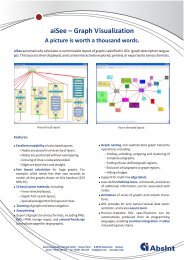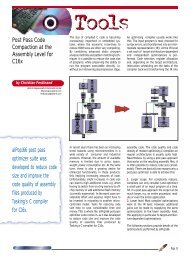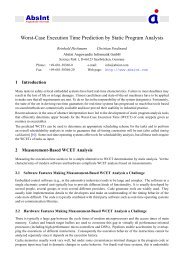5 Graph Description Language (GDL) - Absint
5 Graph Description Language (GDL) - Absint
5 Graph Description Language (GDL) - Absint
Create successful ePaper yourself
Turn your PDF publications into a flip-book with our unique Google optimized e-Paper software.
For details on user actions, see section User Actions (p. 20) and also be refered to useractionname<br />
on p. 89.<br />
• useractionname<br />
Type: integer : string<br />
Default value: 1 : “User Action 1”, 2 : “User Action 2”, 3 : “User Action 3”,<br />
4 : “User Action 4”<br />
Attribute of: top-level graph<br />
<strong>Description</strong>:<br />
This attribute enables names for the user actions menu entries in the Auxiliaries menu to<br />
be introduced.<br />
These names appear in the submenu of the menu item Auxiliaries in the menu line. For<br />
details on user actions, see section User Actions (p. 20) and useractioncmd on p. 88.<br />
• vertical_order<br />
Type: integer or maxlevel<br />
Default value: none (corresponds to -1)<br />
Attribute of: subgraphs<br />
<strong>Description</strong>:<br />
In a hierarchical layout, this attribute specifies the vertical position of a summary node of<br />
a folded subgraph. maxlevel tries to position the node as the maximum calculated level.<br />
Generally for all nodes, their vertical position is called their level or rank (see p. 117). level<br />
is a synonym for vertical_order.<br />
All nodes of level 0 form the uppermost layer (the first layer), if the orientation is top-down.<br />
Nodes of level 1 form the second layer, etc.<br />
The level specification is not in effect unless automatic layout is being calculated. Layout<br />
is calculated automatically if there is at least one node without a specified location (see loc<br />
attribute for nodes (p. 96) and summary nodes (p. 78).<br />
Note: The level specification may conflict with a near edge (p. 44) specification, because<br />
the source and target node of a near edge have to have the same level. In this case, the level<br />
specification of the source or the target node of the near edge is ignored.<br />
• view<br />
Type: cfish, fcfish, dcfish, pfish, fpfish, dpfish<br />
Default value: normal view, i. e. no fish-eye view<br />
Attribute of: top-level graph<br />
<strong>Description</strong>:<br />
This attribute enables one of the six fish-eye views to be selected.<br />
If a graph is large only a small amount of it is visible in the graph window because of the<br />
fixed size of the window. Reducing the graph so that it fits into the window causes details<br />
to no longer be recognizable. The solution to this is fish-eye views. A fish-eye view is a<br />
coordinate transformation, causing the view of the graph to be distorted.<br />
There is a focus which is magnified so that all the details can be seen. Parts of the graph that<br />
are far away from the focus are scaled down.<br />
89





